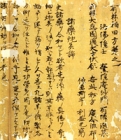Japanese Gallery (Honkan) Room 16
February 28, 2006 (Tue) - April 23, 2006 (Sun)
During the Edo period (1603-1868), Japanese medical science was dominated by doctors whose knowledge and techniques of the trade were based on science that was developed in China. Members of the Taki family, who were descendants of Tanba Yasunori-the author of Ishinpo (ancient medical book) in the 10th century - played a central role in the practice of Chinese medicine. In April 1765, appealing the necessity to create a medical institute to the Tokugawa government, Taki Genko (1695-1766) established a private medical school known as Seijunkan in Kanda Sakucho, which was also the site of an astronomical observatory. Seijunkan suffered fire many times, but Genko's son Gentoku (1732-1801) maintained the school at his own expense. In 1791, when the school was under the supervision of Taki Genkan (1755-1810), it became a public institution under the jurisdiction of the Tokugawa government and the name was changed to the Igakukan.
In addition to teaching medical science, Genkan collected important old medical books from China and Japan, collated them, and published revised editions. Behind the scenes of this reorganization of classical medical books, there seems to have been an intention to compete with Western medical science, which was becoming increasingly popular at the time. In 1849, when the government's control of European books began, all publications of medical books were required to have permission from the Igakukan.
In the Meiji period (1868-1912), more than 2,000 volumes of the books of Igakukan were transferred to the Meiji government's Museum Bureau, which were later divided and are now housed in the collections of the Tokyo National Museum, National Archives, and Imperial Household Agency's Archives and Mausolea Department.
The present display mainly consists of medical books from the museum's collection to introduce the history of Igakukan, which collected, collated, transcribed and published old Japanese and Chinese medical books. It also shows how Western medical science was accepted in Japan.

